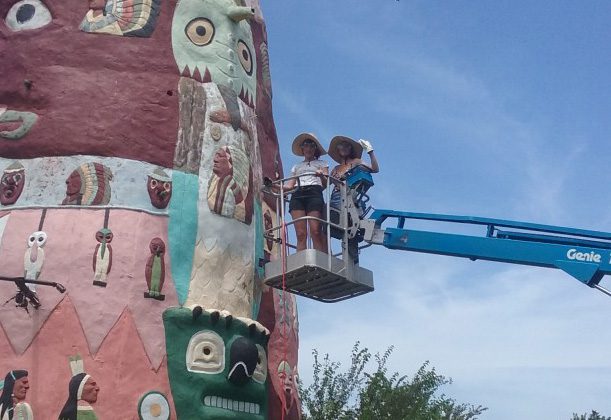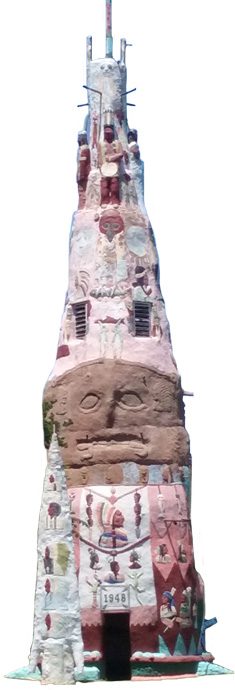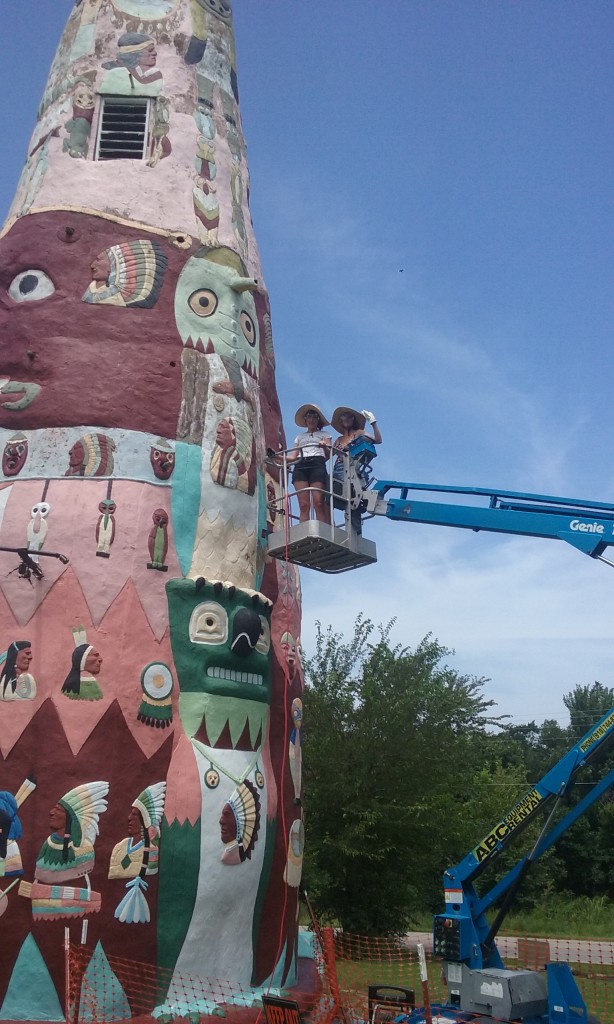
[dropcap]Paint-stained[/dropcap] hands hug a cup of coffee after more than a month of 14-hour days.
“I’ve never done anything like this,” Erin Turner, a freelance artist currently living in Brooklyn, N.Y., says. “It’s awesome, because it’s been like a research process, and clearly we wanted to make the best decisions for the structure and for the park and for the future.”
In 2014, Turner and Margo Hoover, Tulsa natives and childhood friends, journeyed to Foyil, Okla., for the first time, venturing into Ed Galloway’s Totem Pole Park.

The day before their trip, Turner had been in a friend’s studio. There, old, poster-sized images from the park, images Turner had seen many times but which had never grabbed her attention, now stirred conversation. Her friend asked, “You’ve never been there?” And with Turner’s “no” lingered an innocent ignorance. The next day, they were in the car, Hoover included, making the 45-minute trip northeast to Foyil.
Turner and Hoover would leave the park that day, having to return to their professional lives – Turner to Brooklyn and Hoover to her role as an art and physical education teacher in Oakland, Calif. But the words they heard from an employee that day, “Been looking for someone to paint the totem pole for years,” could not be unheard, and for the next year, their minds would be in Foyil – the fulcrum of their newfound fascination –finding the funding to make the more-than-60-year-old structure new.
Ed Galloway, a grassroots artist born in the late 1800s, found his craft in woodworking and blacksmithing. The park’s construction began in 1937 when he retired from teaching art at Sand Springs Home, a non-profit supporting children unable to stay in their home for a number of reasons. For the next 20 years, while residing on the property, Galloway constructed a 90-foot-tall totem pole, among other structures.
In the early ‘80s, conversation first began concerning a large-scale restoration of the park, Turner says, The Kansas Grassroots Arts Association (KGAA); SPACES, an international nonprofit specializing in arts environments; and the Rogers County Historical Society, owner of the park, were the key players. They did the meticulous work in choosing the color scheme that would match Galloway’s. Using a mural found in the Fiddle House, Galloway’s studio and now a museum, and gray-scale photographs of the original totem pole, the groups found a match and went to a local company to get the same style latex paint that Galloway would have used.
[pullquote]It’s one of the coolest structures I’ve ever seen. It has a lot of history. [/pullquote]After starting a $5,000 online funding campaign and receiving money from the Rogers County Historical Society, as well as support from some other organizations, Turner and Hoover inched closer to their hopes of restoring the structure. The duo planned to use the same latex paint as the original restoration, but when they contacted SPACES to tell them about their project, they were told to ditch the latex paint.
“[SPACES told us], ‘We no longer recommend latex paint, we recommend this other paint company called Keim and its mineral silicate-based paint,’” Turner says. “It’s like wonder paint, and way more expensive.”
Though more costly, the new paint helps make the work that Turner and Hoover are doing last.
“It doesn’t chip, it doesn’t flake, it doesn’t break down with UV rays, so it’s not going to fade,” she adds.


























